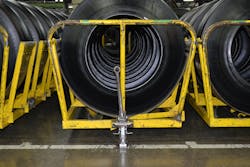Data provided to the International Trade Commission (ITC) shows imported truck and bus tires from China undersold domestic like products in 55 of 56 quarterly comparisons.
At the same time, the ITC says the underselling didn’t force a drop in U.S. tire prices.
The disconnect in prices is revealed in a 154-page explanation of the ITC’s vote on March 11 to continue its preliminary investigation of imported truck and bus tires from China. The U.S. Department of Commerce is now conducting its own investigation of whether imported tires from China should be subject to countervailing and anti-dumping tariffs.
Four domestic truck tire producers — Bridgestone Americas Tire Operations LLC, Continental Tire the Americas LLC, Goodyear Tire & Rubber Co., and Michelin North America Inc. — and 21 importers provided pricing data for four products.
“The data show that subject imports undersold the domestic like product in 55 of 56 quarterly comparisons. Virtually all of the subject imported tires for which prices were reported undersold domestic industry prices.
“The data also indicate that the underselling margins of subject imports were high, ranging from 13.7% to 67%, and that these underselling margins increased steadily over the course of the period of investigation. This underselling enabled subject imports to gain market share at the expense of the domestic industry during the period of investigation. We find this underselling to be significant for purposes of our preliminary determinations.”
But in the next paragraph, the ITC says the prices of those imported tires didn’t depress the prices of U.S. products “to a significant degree.”
The manufacturers and importers compared prices on tires in these sizes.
11R22.5, 16 ply rating, load range H, speed rating L
11R24.5, 16 ply rating, load range H, speed rating L
295/75R22.5, 14 ply rating, load range G, speed rating L
285/75R24.5, 14 ply rating, load range G, speed rating L
“The pricing data indicate that both prices for the domestic like product and subject imports declined over the period of investigation. From 2013 to 2015, declines in prices for the domestic like product of the four pricing products ranged from 10.9% to 13.5% for aftermarket sales, and from 8.2% to 12.3% for OE sales.
“Subject import price declines for aftermarket sales ranged from 30.6% to 36.3%.”
The commission notes that the price drops coincided with a drop in raw material prices, and at this point, the ITC isn’t able to determine whether the domestic price declines are due to imports, or other factors. The ITC says it will seek additional information in the next stage of the investigation regarding the factors that contributed to the price declines.
At the same time, the ITC said it couldn’t determine that imported truck and bus tires prevented domestic tire manufacturers from increasing prices.
“The domestic industry’s unit costs declined, as did its ratio of cost of goods sold to net sales. Thus, the domestic industry did not have an incentive to raise its prices due to increasing costs. Further, even though apparent consumption increased, the record in these preliminary investigations does not show any unsuccessful attempts by the domestic industry to raise its prices.”
A dissenting view
Two ITC members saw no indication that the U.S. tire industry was being harmed or threatened by truck and bus tires imported from China, but they were in the minority. Still, Commissioners Meredith Broadbent and Scott Kieff presented their dissenting views.
They based their dissenting votes on four factors, two of which come down to dollars and cents: “the lack of significant price-depressing or suppressing effects, and the high and increasing profitability of the domestic industry throughout the period of investigation.”
As to the latter, the commissioners wrote, “The domestic industry’s performance improved in almost every category for which information was collected over the period of investigation.”
Capacity utilization increased, from 83.8% in 2013 to 93.5% in 2015. Domestic and export shipments in 2015 were higher than two years earlier, and net sales were higher, too. The number of production workers, their hours worked and their wages paid, all rose.
And, “the domestic industry’s financial performance improved in every metric.” The industry “had high and rising profits” throughout the period of investigation.
“Not only did the industry show consistent and significant improvement in almost every metric, it did so as subject import volume was increasing. The industry’s highest levels of production, capacity utilization, employment, and profits occurred in 2015, as subject import volume and market share peaked.” — Joy Kopcha



